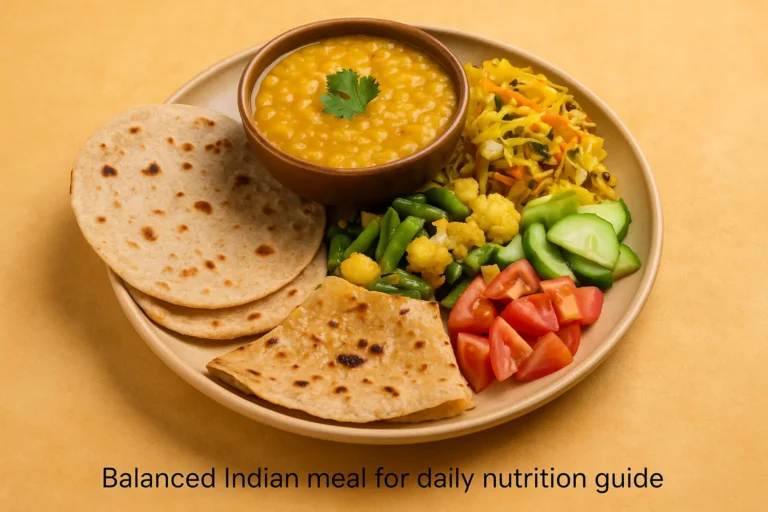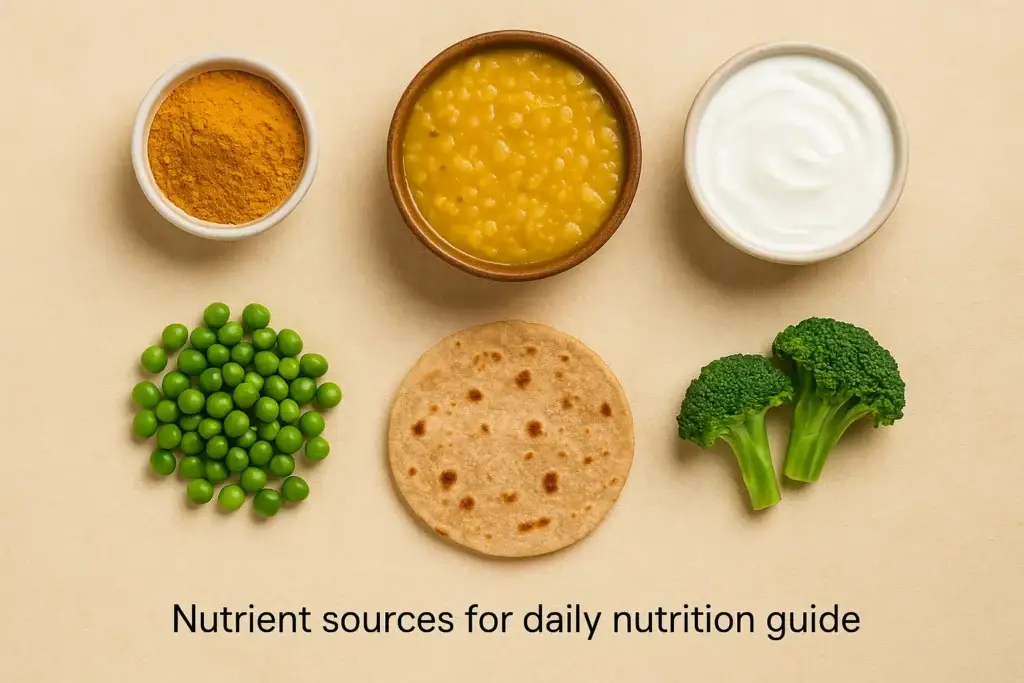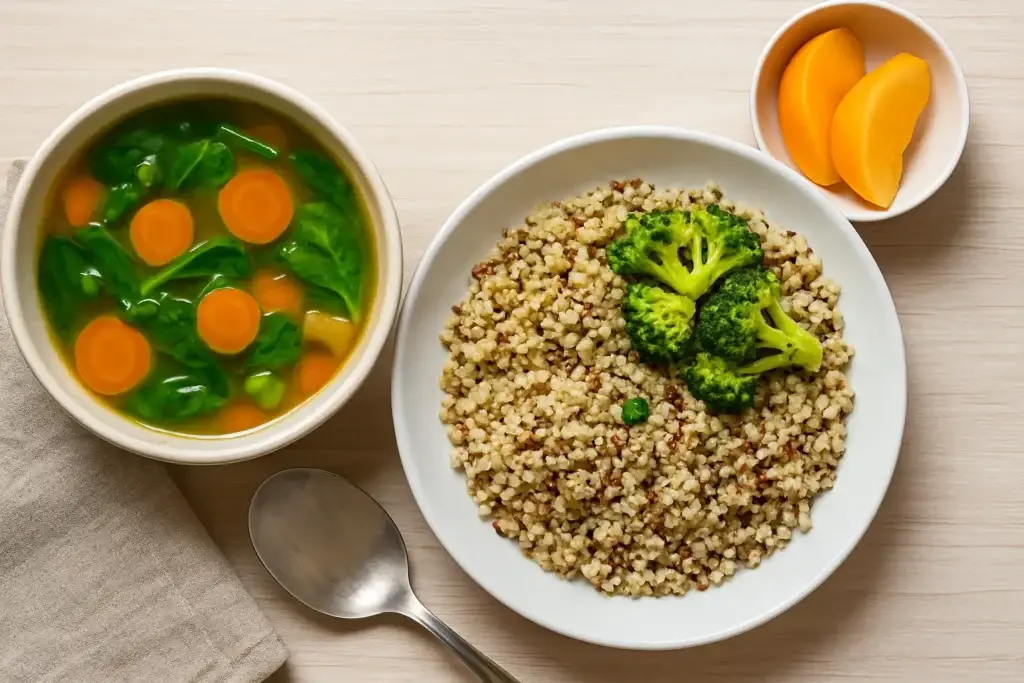Introduction
Struggling with fatigue, lack of focus, or constant snack cravings? You don’t need another fad diet or energy drink – just a well-structured daily nutrition guide offering a healthy Indian diet to fuel your body effectively. This daily nutrition guide provides a practical, sustainable approach to eating well, staying hydrated, and timing your meals to optimize energy and health.
It eliminates the need to count every calorie or give up beloved Indian dishes like roti, dal, or curd. Instead, this daily nutrition guide helps you create a smart routine that fits your lifestyle, whether you’re juggling a demanding job, studying, or managing a household. By embracing this daily nutrition guide, you can nourish your body with balanced meals and maintain consistent energy through a healthy Indian diet.

It’s designed to be flexible, allowing you to enjoy familiar foods while meeting nutritional needs. For a visual breakdown of food portions and Indian plate examples, check out How to Build a Perfectly Balanced Plate for Everyday Nutrition.
Why a Daily Nutrition Guide Changes Everything
Without a daily nutrition guide, eating habits often fall victim to cravings, convenience, or emotional triggers, leading to bloating, low energy, or weight gain. This daily nutrition guide provides a clear roadmap to avoid these pitfalls through effective meal planning.
Here’s why this daily nutrition guide is transformative
- Balanced Meals for Steady Energy This daily nutrition guide ensures a mix of carbohydrates, proteins, fats, and micronutrients, preventing energy spikes and crashes. For example, a breakfast of vegetable poha and curd provides lasting energy compared to sugary cereals.
- Fewer Cravings Regular, nutrient-rich foods in your daily nutrition guide stabilize blood sugar, reducing the urge to snack on unhealthy options like chips or mithai.
- Better Digestion Consistent meal timing and fiber-rich foods, as outlined in this daily nutrition guide, promote a healthy digestive system, preventing discomfort like bloating.
- Lifelong Habits This daily nutrition guide fosters mindful eating, making healthy choices intuitive. It’s about creating routines that last, not following restrictive rules.
- Improved Focus and Productivity A daily nutrition guide fuels your brain, enhancing mental clarity and mood. A balanced lunch with dal, roti, and vegetables keeps you sharp through afternoon tasks.
This daily nutrition guide isn’t about perfection—it’s about progress. It removes guesswork, empowering you to make informed food choices daily. For instance, meal planning with a mid-morning snack like a banana and almonds prevents impulsive eating. A lighter dinner ensures better sleep.
What Your Body Needs Every Day
To thrive, your body requires a balance of macronutrients (carbohydrates, proteins, fats), micronutrients (vitamins and minerals), and hydration. This daily nutrition guide outlines these essentials, their roles, and how to incorporate them using nutrient-rich foods from a healthy Indian diet, aligned with global nutrition guidelines.
| Category | Why It Matters | Common Sources |
|---|---|---|
| Carbohydrates | Primary energy source for brain, muscles, and daily activities | Roti, rice, oats, millets, whole wheat bread |
| Protein | Builds and repairs tissues, supports immunity, maintains muscle mass | Dal, curd, paneer, chicken, tofu, eggs |
| Healthy Fats | Supports brain health, hormone production, joint mobility | Ghee, nuts, seeds, coconut oil, olive oil |
| Fiber | Promotes digestion, regulates blood sugar, keeps you full longer | Fruits, vegetables, whole grains, legumes |
| Vitamins and Minerals | Essential for organ function, immunity, cellular health | Leafy greens, fruits, spices, fortified foods |
| Hydration | Facilitates nutrient transport, regulates body temperature, prevents fatigue | Water, buttermilk, lime water, herbal teas |

Carbohydrates Your Body’s Fuel
Carbohydrates are the cornerstone of energy in your daily nutrition guide, powering physical activity and brain function. Complex carbohydrates, like those in whole grains, release energy slowly, keeping you fueled longer. Indian staples like brown rice, millets (jowar, bajra, ragi), whole wheat roti, or oats are ideal choices from a healthy Indian diet.
For example, starting your day with vegetable poha or millet porridge provides steady energy without the sugar crash of refined carbs. Millets are nutrient-rich foods and versatile, perfect for rotis, khichdi, or upma.
This daily nutrition guide suggests getting 40–50% of your daily intake from complex carbs. Pairing them with protein or fiber, like roti with dal, slows digestion for sustained energy. Avoid over-reliance on refined carbs to stay energized.
Protein The Building Block
Protein is vital for tissue repair, muscle maintenance, and immunity in your daily nutrition guide. It also promotes satiety, reducing overeating. Indian diets offer abundant protein sources, making it easy to integrate into every meal as part of a healthy Indian diet.
Vegetarians can rely on lentils (moong, masoor, chana dal), paneer, tofu, curd, and sprouts. Non-vegetarians can include eggs, chicken, or fish. A lunch of rajma with rice or paneer sabzi with roti delivers a protein punch.
Aim for 15–25 grams of protein per meal. A small bowl of dal provides 7–9 grams, while a boiled egg adds 6 grams. Combining plant-based proteins ensures all essential amino acids are covered.
Healthy Fats Brain and Body Support
Healthy fats are essential for brain health, hormone production, and joint mobility in your daily nutrition guide. They enhance nutrient absorption, particularly for fat-soluble vitamins like A, D, E, and K. In Indian cooking, ghee offers rich flavor when used sparingly.
Nuts (almonds, walnuts), seeds (flaxseeds, chia seeds), and oils like coconut or olive oil are great sources. Adding a teaspoon of ghee to dal boosts flavor and provides healthy fats. A handful of almonds makes a nutrient-rich snack.
This daily nutrition guide suggests 20–30% of daily calories from fats. Sprinkling seeds over curd or salads is an easy way to incorporate them without complicating meal planning.
Fiber Digestive Health and Satiety
Fiber is a powerhouse nutrient in your daily nutrition guide, promoting digestion, regulating blood sugar, and keeping you full longer. It’s crucial for preventing overeating and maintaining gut health. Indian diets offer fiber-rich foods like vegetables (bhindi, palak, carrots), fruits (guava, apples), whole grains (brown rice, millets), and legumes (chickpeas, lentils).
A meal of mixed vegetable sabzi, dal, and brown rice delivers a hearty dose of fiber. Aim for 25–30 grams of fiber daily. A medium apple provides 4 grams, a bowl of dal adds 6–8 grams, and mixed vegetables contribute 5 grams.
Seasonal produce like bhindi or guava boosts fiber and adds variety. This daily nutrition guide emphasizes pairing fiber with adequate water for smooth digestion.
Vitamins and Minerals Cellular Health
Micronutrients like vitamins A, C, D, E, and K, and minerals like calcium, iron, and magnesium, are critical for organ function, immunity, and cellular health in your daily nutrition guide. Indian cuisine is rich in these nutrients, thanks to nutrient-rich foods and colorful vegetables, fruits, and spices.
Turmeric contains curcumin, a potent antioxidant. Spinach and leafy greens provide iron and calcium, while citrus fruits like oranges offer vitamin C. A salad with spinach, tomatoes, and lemon maximizes nutrient absorption.
To ensure a broad spectrum, eat a variety of nutrient-rich foods daily. Pairing vitamin C-rich fruits with iron-rich greens enhances absorption. Fortified foods help fill gaps for nutrients like vitamin D.

Hydration The Unsung Hero
Water is the backbone of your daily nutrition guide, supporting nutrient transport, temperature regulation, and energy maintenance. Even mild dehydration can cause fatigue, headaches, and poor focus. In India’s warm climate, staying hydrated is critical with effective hydration tips, as supported by research on hydration from sources like World Health Organization (WHO). This resource can help you adjust water intake based on your individual needs and activity level.

Meal Timing and Daily Nutrition Flow
Timing your meals is a critical component of this daily nutrition guide, as it prevents blood sugar spikes, reduces cravings, and supports digestion through strategic meal planning, backed by expert advice on meal timing. Below is a suggested daily meal schedule tailored to a balanced healthy Indian diet.
| Time | What to Eat |
|---|---|
| Morning (7–8 AM) | Balanced breakfast with fiber and protein (e.g., poha with veggies, curd) |
| Mid-Morning (10–11 AM) | Light snack like fruit or nuts to sustain energy |
| Afternoon (1–2 PM) | Main meal with protein, vegetables, whole grains (e.g., roti, dal, sabzi) |
| Evening Snack (4–5 PM) | Hydrating drink or light snack like roasted chana or sprouts |
| Dinner (7–8 PM) | Lighter meal with more vegetables, less starch (e.g., vegetable soup, quinoa) |
Pro Tip Eat every 3–4 hours, as advised in this daily nutrition guide, to maintain steady energy. Finish dinner 2–3 hours before bedtime to support digestion.
Why Meal Timing Matters
Your body’s circadian rhythm influences metabolism and digestion. This daily nutrition guide emphasizes consistent meal times to improve nutrient absorption and prevent energy slumps. A protein-rich breakfast like upma with curd jumpstarts your metabolism.
A lighter dinner with vegetable soup avoids overloading your digestive system before sleep. Spacing meals and snacks evenly prevents long hunger gaps. For busy schedules, meal planning with a batch of dal makes it easier to follow this daily nutrition guide.
Hydration and Liquid Nutrition Habits
Hydration is a cornerstone of this daily nutrition guide, often overlooked despite its role in digestion, nutrient transport, and mental clarity. Below are key hydration tips and their benefits.
| Habit | Why It Helps |
|---|---|
| 1 glass of water after waking | Kickstarts digestion, rehydrates after sleep |
| Herbal tea mid-morning | Soothes gut, curbs mid-morning cravings |
| 1 glass of water before meals | Prevents overeating, aids digestion |
| Buttermilk or lime water | Replenishes electrolytes, supports gut health |
| Avoid fruit juices and sodas | Reduces sugar spikes, empty calories |
Hydration Goal Aim for 8–10 glasses (2.5–3.5 liters) of water daily, as recommended in this daily nutrition guide, adjusting for activity and climate.
Additional Hydration Tips
- Infuse Your Water Add cucumber, mint, or lemon slices to make water appealing, encouraging regular sipping as part of your daily nutrition guide.
- Track Intake Use a 1-liter bottle and aim to finish 2–3 bottles daily. Keep it visible on your desk or carry it on the go.
- Limit Caffeine Excessive coffee or tea can dehydrate you. Balance with water or herbal teas like tulsi, following hydration tips.
- Electrolyte Boost Include buttermilk or coconut water, especially after workouts, to restore minerals.
Starting your day with warm water and lemon activates your digestive system. Sipping herbal tea mid-morning curbs cravings. These hydration tips ensure you stay hydrated.
Daily Nutrition Guide Sample Plan
This daily nutrition guide includes a detailed sample plan for a day of balanced eating, tailored to Indian dietary preferences through meal planning.
Morning (730 AM)
- Poha or Oats with Veggies A serving of poha with flattened rice, mixed vegetables, and turmeric for anti-inflammatory benefits. Alternatively, oats with milk and fruits like bananas.
- Boiled Egg or ½ Cup Curd Adds 6–7 grams of protein to keep you full.
- Ginger Tea or Jeera Water Aids digestion, provides a caffeine-free start.
Why It Works This breakfast combines complex carbs, fiber, and protein for sustained energy, keeping you focused.
Mid-Morning (1030 AM)
- 1 Banana or Seasonal Fruit Provides natural sugars and potassium. Seasonal fruits like guava add variety.
- 5 Almonds or 1 tsp Flaxseeds Offers healthy fats and fiber to curb hunger.
Why It Works A light snack prevents energy dips and avoids unhealthy options.
Lunch (100 PM)
- 2 Rotis or ¾ Cup Brown Rice Whole grains provide sustained energy and fiber.
- Mixed Vegetable Sabzi and Moong Dal Includes fiber-rich vegetables and protein-packed dal.
- Side Salad and 1 tsp Ghee A salad with cucumber and carrots adds micronutrients, while ghee enhances flavor.
- Buttermilk Hydrates and supports digestion.
Why It Works This balanced meal delivers all macronutrients, supporting productivity.
Evening Snack (430 PM)
- Roasted Chana or Boiled Moong Protein-rich snacks maintain energy.
- Herbal Tea or Lemon Water Hydrates and refreshes without sugar.
Why It Works A light snack prevents overeating and curbs cravings.
Dinner (730 PM)
- Vegetable Soup or Stir-Fry High in fiber, using vegetables like spinach.
- Quinoa or Brown Rice with Dal A lighter carb and protein combo.
- Fruit Slices or Turmeric Milk Supports digestion and relaxation.
Why It Works A lighter dinner promotes restful sleep.
This sample plan is flexible—swap ingredients like chana dal for moong. Meal planning with balance and variety is a core principle of this daily nutrition guide.

Mistakes That Disrupt Your Nutrition
Even with this daily nutrition guide, common mistakes can derail your efforts. Below are pitfalls to avoid and better alternatives.
| Mistake | Better Option |
|---|---|
| Skipping breakfast | Eat a light, balanced breakfast (e.g., curd with fruit) |
| Drinking sugary beverages | Opt for herbal tea, lime water, or plain water |
| No protein in meals | Include dal, paneer, tofu, or eggs in every meal |
| Heavy carbs at dinner | Reduce rice/roti, increase vegetables |
| Insufficient water intake | Keep a 1-liter bottle handy, sip throughout the day |
Additional Pitfalls to Avoid
- Overeating at One Meal Large meals cause bloating. This daily nutrition guide recommends smaller, frequent meals. Meal planning can split a heavy lunch into a moderate meal and a snack.
- Relying on Processed Foods Packaged snacks like namkeen are high in sodium. Choose nutrient-rich foods like roasted chana, as suggested in this daily nutrition guide.
- Ignoring Portion Sizes Even healthy foods can lead to weight gain if portions are too large. Refer to How to Build a Perfectly Balanced Plate for Everyday Nutrition.
Other mistakes include eating too quickly, which impairs digestion. Neglecting meal planning leads to takeout. This daily nutrition guide suggests mindful eating and weekly prep.
Daily Nutrition Tracker
Tracking your progress with this daily nutrition guide builds accountability. Use this checklist to monitor daily goals.
| Daily Goal | Complete (✓) |
|---|---|
| Ate vegetables in 2 meals | |
| Had protein in every meal | |
| Ate 1 serving of fruit | |
| Drank 2.5–3.5 liters of water | |
| Avoided sugary drinks | |
| Finished dinner before 8 PM | |
| Took a 5-minute walk after meals |
How to Use the Tracker
- Print or save digitally on your phone.
- Check off each goal daily as part of your daily nutrition guide.
- Review weekly to identify patterns.
This tracker reinforces habits like including greens or following hydration tips.
Common Questions Answered
1. Can I follow this daily nutrition guide if I’m vegetarian?
Yes! This daily nutrition guide suits vegetarians with dals, paneer, and sprouts. A lunch of rajma with rice provides 10–12 grams of protein, while roasted chana adds 5 grams.
2. How many times should I eat in a day?
This daily nutrition guide recommends three meals and two snacks every 3–4 hours. Meal planning with a mid-morning fruit and evening nuts keeps you satisfied.
3. Does this daily nutrition guide work for weight loss?
Yes, this daily nutrition guide manages hunger and cravings, supporting weight control. A healthy Indian diet and proper timing avoid empty calories.
4. Is it okay to repeat meals?
Repeating balanced meals is fine in this daily nutrition guide. Roti, dal, and sabzi daily is better than skipping meals.
5. How do I make this daily nutrition guide work on a busy schedule?
Plan and prep meals like a batch of dal. Keep snacks handy. This daily nutrition guide suggests reminders. Check How to Build a Perfectly Balanced Plate for Everyday Nutrition.
6. What if I have dietary restrictions?
This daily nutrition guide is adaptable. Use ragi rotis for gluten-free or soy yogurt for lactose intolerance. Consult a dietitian.
7. How can I make healthy eating affordable?
This daily nutrition guide uses seasonal ingredients. Buy spinach from markets and bulk-buy rice or millets.
Conclusion
This daily nutrition guide is your blueprint for sustained energy and better health without restrictive diets. By focusing on nutrient-rich foods like whole grains and proteins, you can fuel your body effectively. Proper meal timing and hydration ensure steady energy.
The sample plan and tracker make implementation simple. This daily nutrition guide adapts to your needs, whether vegetarian or busy. Avoiding pitfalls sets you up for success. Explore How to Build a Perfectly Balanced Plate for Everyday Nutrition. Start today with this daily nutrition guide.
Disclaimer
The information in this daily nutrition guide is intended for general guidance and informational purposes only. It is not a substitute for professional medical advice, diagnosis, or treatment. Before making significant dietary changes, especially if you have medical conditions, dietary restrictions, or are pregnant, consult a qualified dietitian or healthcare professional. Individual nutritional needs vary based on factors like age, activity level, and health status. The authors and publishers of this daily nutrition guide are not responsible for any adverse effects resulting from following the advice provided.
Suggested Next Read
How to Build a Perfectly Balanced Plate for Everyday Nutrition
Learn how to portion meals using Indian ingredients, with visual examples.
Quick Resources
- Download PDF Version of the Daily Nutrition Guide
- Subscribe for Weekly Wellness Insights
- Explore More Nutrition Guides

I’m a passionate wellness coach with over 5 years of experience helping people build healthier lives through balanced nutrition and practical lifestyle habits. I focus on science-backed guidance, including whole foods, mindful eating, and smart protein choices, to support energy, digestion, and long-term well-being. My approach is flexible, realistic, and built on the belief that prevention is better than cure because lasting health starts with daily choices.

